Sometimes the greatest surprises come in the smallest sizes.
Such is certainly the case with Puerto Rico.
For an island that’s only a maximum of 65km in height and 180km in width, it’s almost like it boasts an incredibly rich and diverse cuisine you would come to expect from a more massive land with a population far greater than just 5 million.
And yet, the Puerto Rican cuisine comes with a vast menu of options (pun intended).
Really, arroz de mamposteao is just the tip of the iceberg.

Mamposteao, The Europeans, the Africans, and the Tainos
Before diving into Puerto Rico’s ethnic history, we felt compelled to discuss a topic clearly on everyone’s minds: mitochondrial DNA!
You see, a lot of interesting genetic work has been done in Puerto Rico to help paint a better picture – and one more accurate than biased historical records can provide – to the overall makeup of what it means to be truly Puerto Rican.
Based on this recent study done on Puerto Rican mitochondrial DNA, a true Puerto Rican heritage quite literally implies a culmination of several distinctive genetic sources.
Here, we’ll look into each source and their corresponding effects on the country’s overall contemporary “rainbow cuisine.”
Related Recipe: You might also like our Portugese Rice Paella
The Tainos
Perhaps most surprisingly about Dr. Martinez’s study was how prevalent Taino mitochondrial DNA was in his population of modern day Puerto Ricans. Up to 62% of his study population still had the mitochondrial DNA – something which is only passed through the mother – of indigenous Taino origin.
But why was this so surprising?
Technically, the Taino have been an extinct population for over 500 years… especially if you were to take old Spanish historical records to heart. In a story very similar to Haiti, Christopher Columbus arrived in 1493 to the island of Boriken, which was inhabited by a peaceful and welcoming Taino population. Over the span of the next 50 years, the Taino population – who had lived on Boriken peacefully for at least the past millennium – were systematically wiped out via Spanish-instigated fighting and Old World European diseases for which they had no immune defenses.
Or so we thought. As the study clearly shows, there remains an overwhelmingly strong influence of Taino genes in the Puerto Rican population of today, and in an odd twist of fate, it is again because of the Spanish.
The Spanish
It seems hardly feasible that the Spanish intended to play any sort of “good guy” part in all of this, but some of their decisions have indirectly led to the preserving and overall persistence of the Taino genealogy despite their actions.
The Spanish first made their way to the island of Boriken as part of Christopher Columbus’s voyage to explore and colonize the New World. Columbus left from the Spanish city of Cadiz with 17 ships and a crew of 1,200-1,500 men.
The decision to bring only men to the island was significant because it essentially forced the Spaniards’ hand to intermarry and mingle with the indigenous people. As a result, Puerto Rico has some of the earliest signs of a burgeoning mestizo mixed-race culture – though this would become prevalent elsewhere like Chile – compared to the rest of the colonized New World.
Even as the distinctly Taino population was decimated, there was an overall accepting attitude on the island towards this type of intermingling, especially between the European men and the indigenous women. As a result, only 12% of Dr. Martinez’s study population had uniquely European mitochondrial DNA.
Which brings us to the source of the final 26%: the African immigrant population.
The Africans
After a period of peaceful coexistence with the Taino, the Spaniards began implementing colonialist policies requiring heavy taxes (or “tributes”) and demanding forced labor from the Taino men. As a result, the previously agricultural Taino men were taken away from their fields in order to extract gold from the gold mines.
Removing the Taino men from being able to tend to their crops proved to have a serious domino effect that ultimately doomed their people. The catastrophic effect that Old World diseases like the measles and smallpox had was due in large part because the Taino could not sustain much of their indigenous agriculture and traditional eating habits.
By the mid-16th century when the Taino were deemed “extinct” from the Spanish, the Spaniards devised the “solution” of importing West and Sub-Saharan African slaves to the island in order to keep their mining and fort-building operations going.
Pretty soon thereafter, however, the yields from the gold mines had dried up. The Spaniards found little added value – with the exception of some sugar cane plantations – in La Isla and instead refocused it as a midway port en route to their more lucrative islands in the Caribbean and Greater Antilles.
Still, in order to supply enough labor and people to sustain this garrison island (now called “Puerto Rico” for rich port), the Spaniards offered freedom both to local African slaves as well as others from West Indie islands who could successfully emigrate. This policy led to a massive influx in the Afro-Puerto Rican population.
The “Melting Pot” Puerto Rican Cuisine
You could say that each culture brought something unique to the table (yes, pun intended) for the overall Puerto Rican cuisine.
As the “home team,” the Taino had mastered the art of tropical agriculture. At the core of the Taino cuisine were roots and tubers like cassava, yams and especially yuca, and they also made abundant use of chili peppers, achiote (or annatto), peanuts and tropical fruits like pineapple and guava.
One of the most significant culinary contributions from the Taino – especially as it pertains to arroz de mamposteao – is the bean. Beans are native to the Americas, and the Taino had various types of beans incorporated into their diet well before the Spaniards’ arrival.
Of course, a majority of Puerto Rico’s culinary influence does come from the Spanish as well. Not only were ingredients like wheat, chickpeas, cilantro, basil, onions and garlic introduced by the Spanish, but they brought over many traditional cooking methods that are prevalent in the cuisine today. The practice of making stews and rice dishes, for example, is a quintessential European import into the island.
There are two Spanish introductions more impactful than all others though: rice and meats. Both play a pivotal role in a traditional mamposteao recipe as well as in other famous national dishes. In particular, the Spaniards brought over their love for pork products (though chicken and beef were also introduced), which has since played a large role in the local Puerto Rican cuisine as well.
You’d be hard pressed to miss a strong African influence in the cuisine as well. Ingredients like coconut, plantains, okra, guandules or pigeon peas, tamarind and much more came over with the Africans as well. The strongest culinary influence, however, might have come from the African preference to fry everything in oil, a technique that has become very prevalent in the modern day cuisine as well. There are some really awesome Puerto Rican recipes like mofongo featuring an exceedingly strong African influence, but those are for another day.
RELATED RECIPE: loving this Puerto Rican dish? Try our Puerto Rican Rum Eggnog
For now, though, onto arroz de mamposteao.
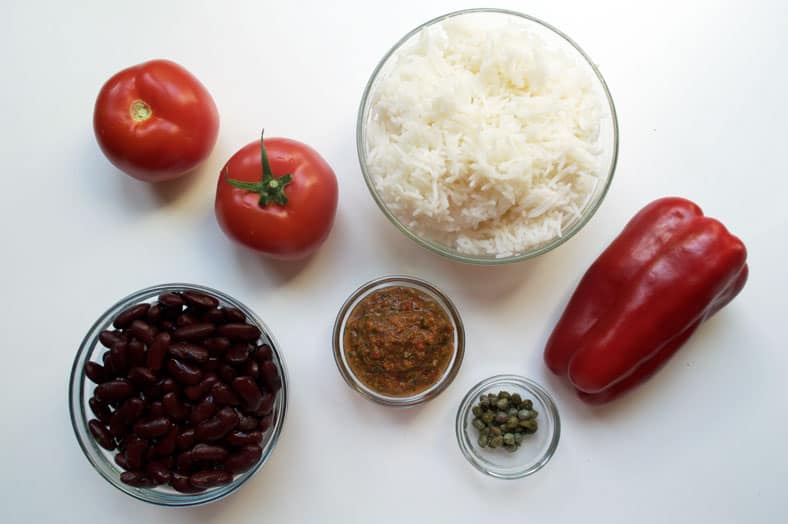
What is Arroz Mamposteao?
Arroz Mamposteao is a Puerto Rican dish that consists of white rice and stewed beans. The rice is usually cooked in a stew, which gives it a unique flavor. It is often served with a side of white rice and beans, and is a popular dish among Puerto Ricans.
Different Types of Puerto Rican Rice
Puerto Rican rice dishes are typically made with white rice, however, there are also many recipes that include rice and beans, or “habichuelas”. Some popular Puerto Rican rice dishes include arroz con pollo (chicken and rice), arroz con gandules (rice with pigeon pies – try our Dominican Pigeon Peas Rice here), and paella (Related Recipe: You might also like our Portugese Rice Paella). You can use different types of white rice, or add a little coconut milk to cook your white rice to get a fragrant bowl of coconut rice instead – this is referred to as arroz con coco – rice with coconut, a favorite for many Colombian dishes!
Related: love rice and beans? Try our Dominican Pigeon Peas Rice recipe
How is Arroz Mamposteao Normally Prepared – Leftover Stewed Beans and White Rice
Arroz mamposteao is a dish that is traditionally made with leftover white rice and red beans. It is a type of rice and beans, and it has become so popular throughout the island that people purposefully make white rice just to make this dish. To make arroz mamposteao, you first need to make white rice and stewed beans. Once you have those two things, you simply mix them together and enjoy!
What to Serve with Arroz Mamposteao
There are many different ways to cook and serve arroz mamposteao, but one of the most popular is to serve it with ripe plantains. Plantains are a type of banana that is usually cooked before being eaten, and they have a sweet taste that goes well with the savory rice dish. ripe plantains can be found at most Hispanic markets, or you can try making them at home by frying sliced plantains in oil until they are golden brown.
The sofrito
Sofrito is a Spanish sauce made from diced tomatoes, onions, garlic, and green peppers. It is used as a base for many Spanish dishes, including arroz mamposteao. This recipe for arroz mamposteao uses sofrito as a flavorful base. The dish is made by sautéing the sofrito in a skillet, then adding rice and beans. The dish can be served with leftover chicken or pork.
About the Recipe
If there were ever a dish to make with any of your leftovers, this would be it.
As luck would have it, that’s actually how the tradition of arroz de mamposteao actually started. The dish itself supposedly started when Puerto Rican grandmothers – in the traditional European form – would combine leftover white rice with beans, season the overall dish with a sofrito and simply let it stew.
And therein lies the uniqueness of this arroz de mamposteao dish compared to the sea of other rice and beans dishes. Rather than combining pre-cooked rice and pre-cooked beans at the end, the key to making a truly authentic arroz de mamposteao is to combine everything in the beginning and to have it all cook together.
The underlying premise to making a delicious arroz de mamposteao is, ironically, to leave it alone. Your goal with it is to let all the flavors elevate one another as it cooks and simmers together.
If you’re cooking with meat (we didn’t), then you’ll start by lightly frying it in olive oil. As the meat starts to brown, you’ll then add in your sofrito (we’ll cover this in a second) and some tomatoes, thereby creating your seasoning into which the rice and beans go.

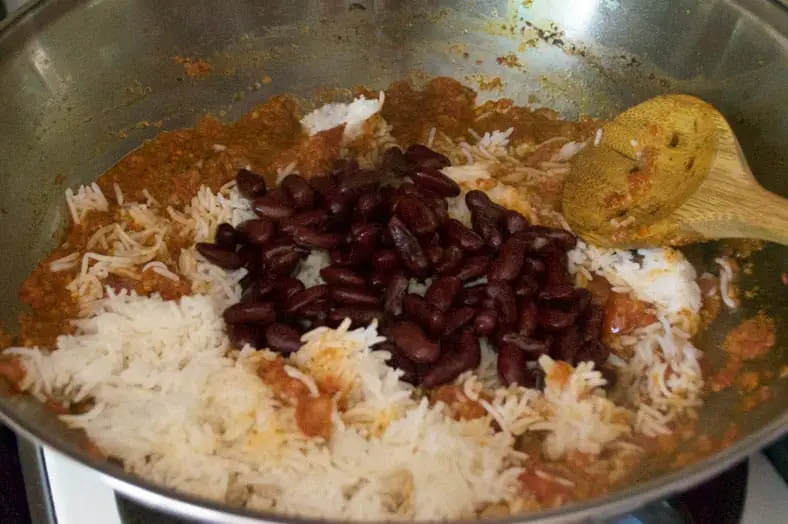
Once you add your rice and beans – which, if you’re using leftovers, should be already pre-cooked – you’ll mix it around in the sofrito and seasoning until it develops a nice reddish hue. Ideally, you’ll want to no longer see any more white in the rice.

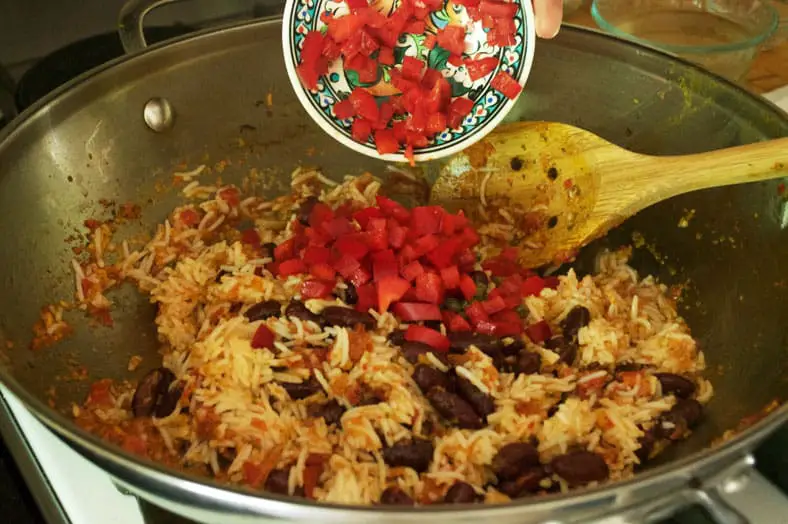
Add in any other ingredients like olives, capers, white wine or even some broth, and then let it simmer for at least an extra 5 minutes together. If you do add a fair amount like 1 cup+ of extra liquid, you might want to let it simmer for a little longer to let more of the liquid reduce.
Finally, take off the heat and serve! It really is that easy.
The Sofrito
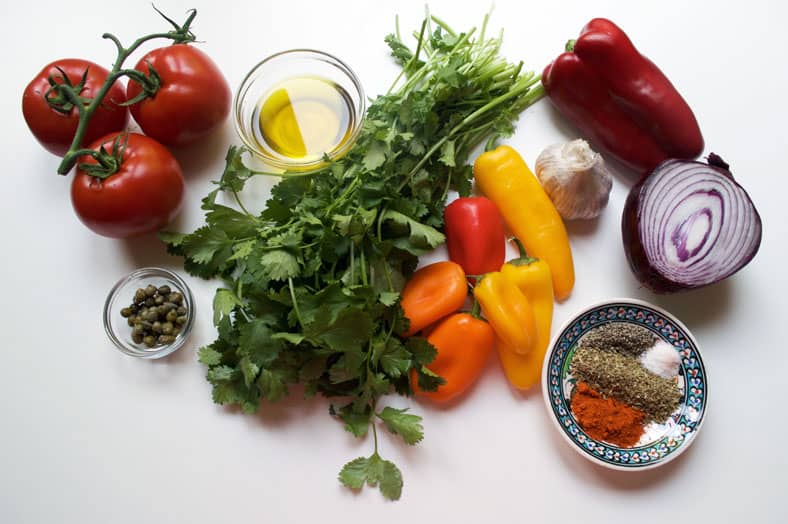
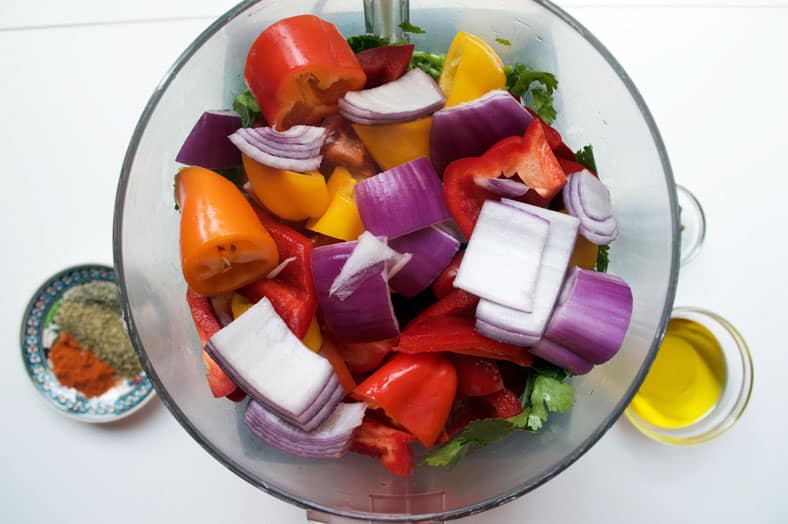
As with most other recipes influenced by the cocina criolla, the Puerto Rican cuisine has a major love for its sofrito. Sofrito acts as the base and the main source of seasoning and flavor for a whole slew of local dishes. Based on its ingredients, it’s easy to see why.
The beauty about any type of sofrito is that it’s very, very easy to make. In the case of a true Puerto Rican sofrito, you’ll take at least some cilantro, various types of peppers and chilis, onions, garlic and oregano and blend them together. Thanks to the deep roots back to Taino cuisine, many will also put in achiote (annatto) into their sofrito for a little extra coloring and pizzazz to the blend.
Honestly, the sofrito is so versatile and so flavorful on just about anything that we’d strongly recommend you make an excess of it. Not only can you make more delicious Puerto Rican dishes with it, but the sofrito also serves as a fantastic seasoning on just about any other type of dish you’d like as well.
Our Take on the Recipe
It’s hard to argue with a source called Puerto Rican Recipes, and so we didn’t as we used them as a baseline for our original reference recipe.
Partly because we like making things a little harder for ourselves, we set out to take on the challenge of making this a fully vegan-friendly dish. Sadly, that meant omitting any possible bacon and chorizo, although the fringe benefit is that it did cut down cooking time as well.
One main improvement we though we could make is to write out our own version of sofrito. We found it a little burdensome early in testing this recipe to come to the point where they say to add sofrito… only for there to be no indication of one. We didn’t want you to have the same struggles, which is why you see one here loosely based off its own reference recipe.
In the absence of having readily available achiote and ajies dulces for our sofrito, we sought to use other spices and ingredients to replicate the effect instead. With the help of spices like cayenne and ingredients like sweet bell peppers and tomatoes, we were able to get a colorful and piquant sofrito that we were really pleased with. If you want a sofrito perhaps a little less spicy, definitely feel free to cut down on any spicy or peppery ingredients.
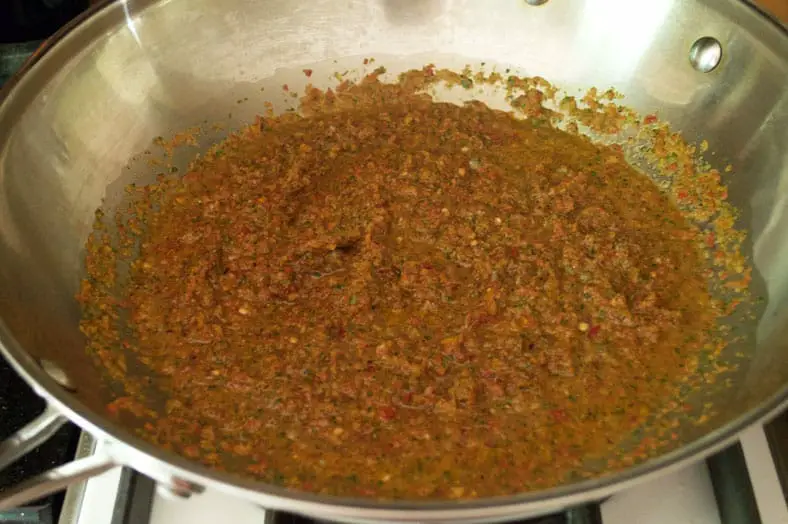
In the recipe itself, we cut down the amount of liquids used for simmering the rice and beans together. Instead of tomato paste, we used fresh tomatoes and their corresponding juices, which allowed us to add a tad less white wine (in place of sherry) and water into the mamposteao. This also gave us a little more leeway to add some more sofrito, which made the dish still very flavorful while retaining its moist and creamy consistency.

All in all, arroz de mamposteao is an incredibly easy one to make, and it’s a fantastic introduction into the wide world of food that the tiny island of Puerto Rico has jam packed into it.
Enjoy!
How would you prepare your arroz de mamposteao or sofrito? Comment below!
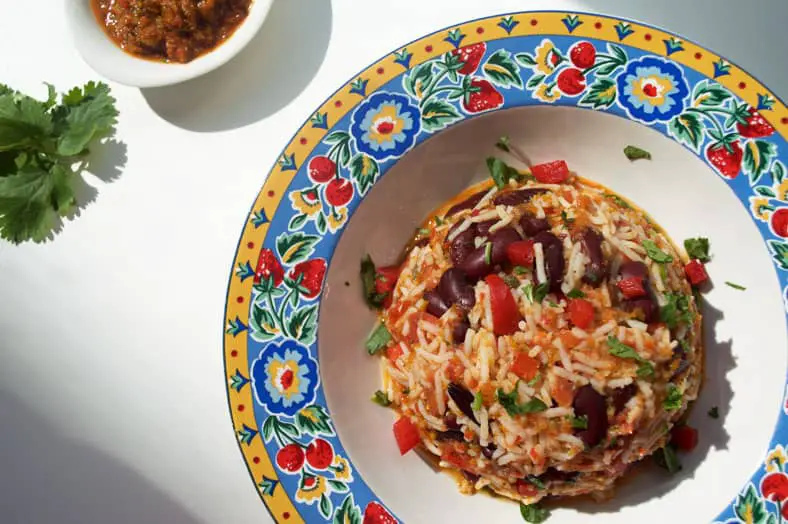
(NOTE: Want to save this recipe for later? You can take home a downloadable PDF version of this recipe by clicking here.)


Arroz Mamposteao: Puerto Rican Rice, Beans and Sofrito
- Total Time: 30 minutes
- Yield: 4 people 1x
Description
Arroz Mamposteao: Puerto Rican Rice, Beans and Sofrito with red kidney beans.
Ingredients
Arroz Mamposteao
- 2 tablespoons olive oil
- 3 ripe tomatoes, so finely diced they’re almost sauce-like
- 1/4 cup sofrito (see below)
- 1 1/2 cups short-grain rice, pre-cooked
- 1 X oz can cooked red kidney beans
- 1 teaspoon capers
- 1 red bell pepper, diced
- 2 tablespoons sherry or white wine
- 1/2 cup water
- 2–3 sprigs of fresh cilantro, chopped for garnish
Sofrito (makes ~2 cups)
- 1/4 cup olive oil
- 1 bunch of cilantro
- 6 cloves of garlic
- 1 large red onion, cut into chunks
- 4–5 small sweet bell peppers (otherwise known as ajies dulces)
- 1 large red bell pepper
- 3 ripe tomatoes, cored and cut into chunks
- 1 tablespoon capers
- 2 tablespoons dried oregano
- 1 teaspoon cayenne pepper
- 1 teaspoon black pepper
- 1 teaspoon sea salt
Instructions
Stage 1 – Prepare the Sofrito
- Take all your ingredients for the sofrito into a food processor (on Amazon) and blitz your ingredients finely together. You want to process everything into the consistency of a sauce
- Next, heat a wok or a saucepan over medium-high heat. Once the pan is hot, pour your sofrito in and begin to stir around for 1 minute
- After a minute, reduce the heat to medium-low and let the sofrito cook for ~10 minutes. If you’re not using pre-cooked rice, this would be a good time to boil and prepare your rice
- When the 10 minutes are up, pour the sofrito into a bowl and keep close by. Now it’s onto the main event
Stage 2 – Making the Arroz Mamposteao
- In the same saucepan from where your sofrito just came, add your two tablespoons of olive oil and increase the heat of the stove to medium-high
- When the oil is nice and hot, add your finely diced tomatoes and stir around for ~30 seconds
- Once your tomatoes start to cook, add in 1/4 cup of the sofrito back into the saucepan. Mix the sofrito in well with the tomatoes for ~1 minute
- Next, add your rice and your beans together and mix the tomato and sofrito sauce well through. The rice will start to take on a slightly reddish hue as it gets coated with sauce. From here, let the rice and beans simmer for 1 minute1 before moving on
- Add in your bell pepper, capers, white wine and water into the saucepan. Reduce the heat on your stove to medium and let the mamposteao cook for 4-5 minutes as you stir occasionally to loosen the ingredients up
- Finally, take your pan off the heat and transfer your arroz mamposteao to your serving dish. Add your cilantro and toss around, and enjoy!
- Prep Time: 10 mins
- Cook Time: 20 mins
- Category: Lunch
- Cuisine: Puerto Rican
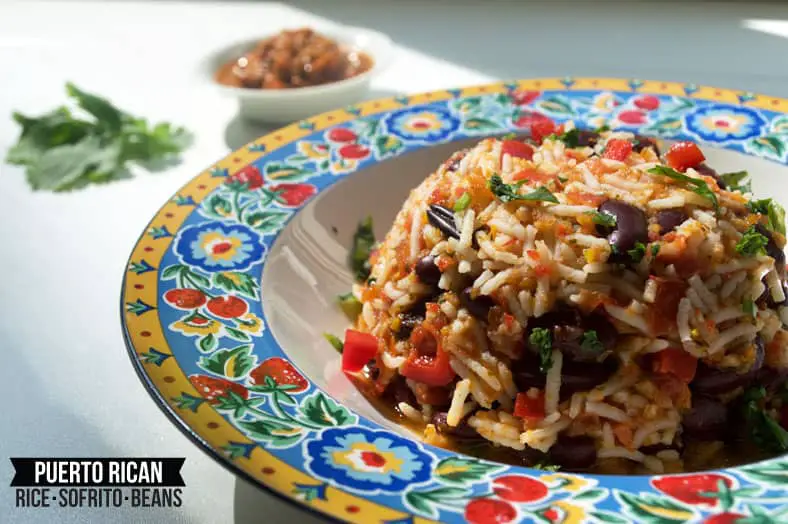

Funny that this sofrito has so much cayenne – the versions I’ve tried (and Puerto Rican food in general that I’ve eaten – in NY mostly) has been rather mild. Anyway, very colorful and lovely looking.
Great point, Laura. The beauty about sofrito is that it can be as spicy/mild as you like (although you can tell which type we prefer). Whether with the teaspoon of cayenne or not, we’d highly recommend giving mamposteao a try 🙂
This is certainly NOT how we make it in Puerto Rico. 👎
Beautifully displayed and explained Heather! Glad our site Recetas Puerto Rico was taken into consideration. Well done! We have also taken the feedback you’ve provided on this article and started including links to great sofrito recipes. Hope to be of great value once again in the near future.
Thanks so much for the kind words, and we’ll definitely be back for some more great recipes again 🙂
PR Sofrito always has ajíes dulce, cilantro and recao (Also known as culantrillo). Recaito is sofrito without the annatto red coloring.
And gandules is in PR and guandules is in DR.